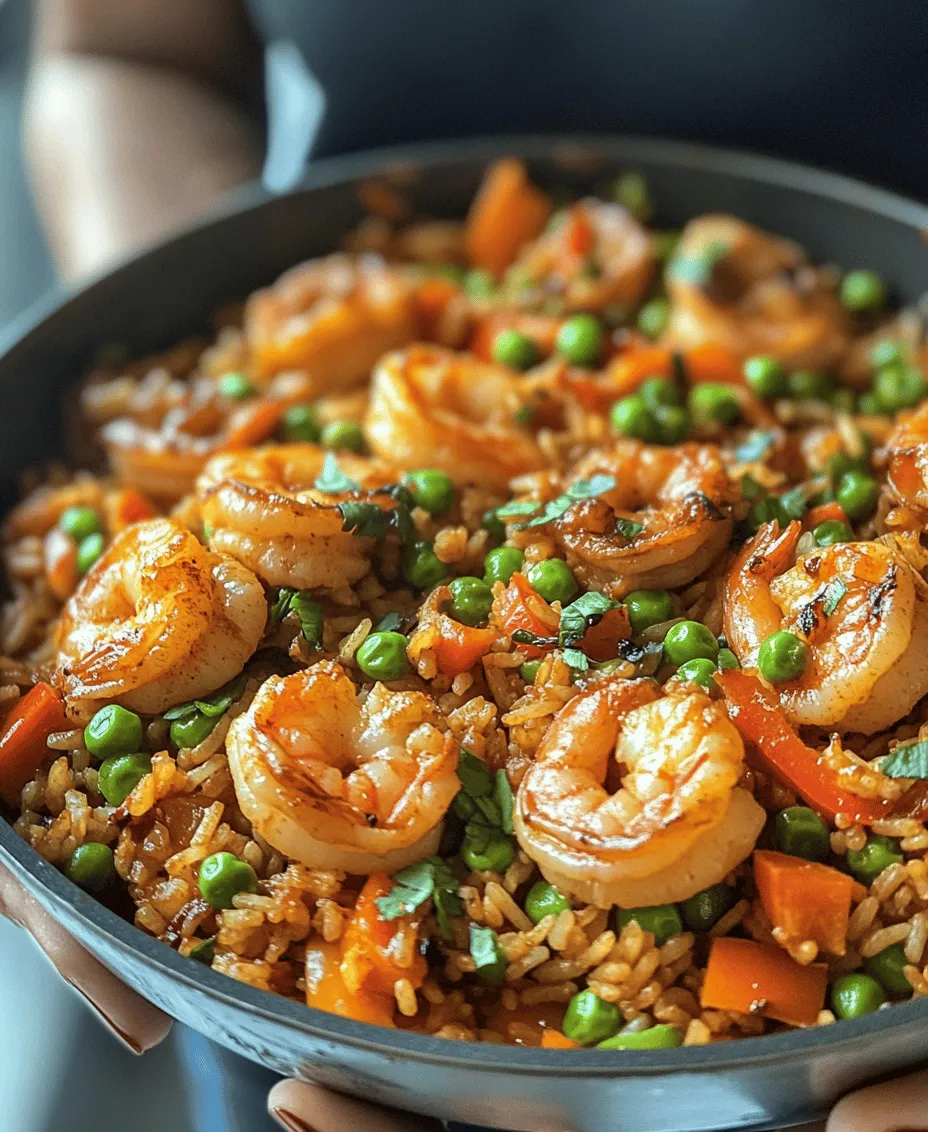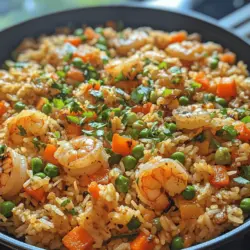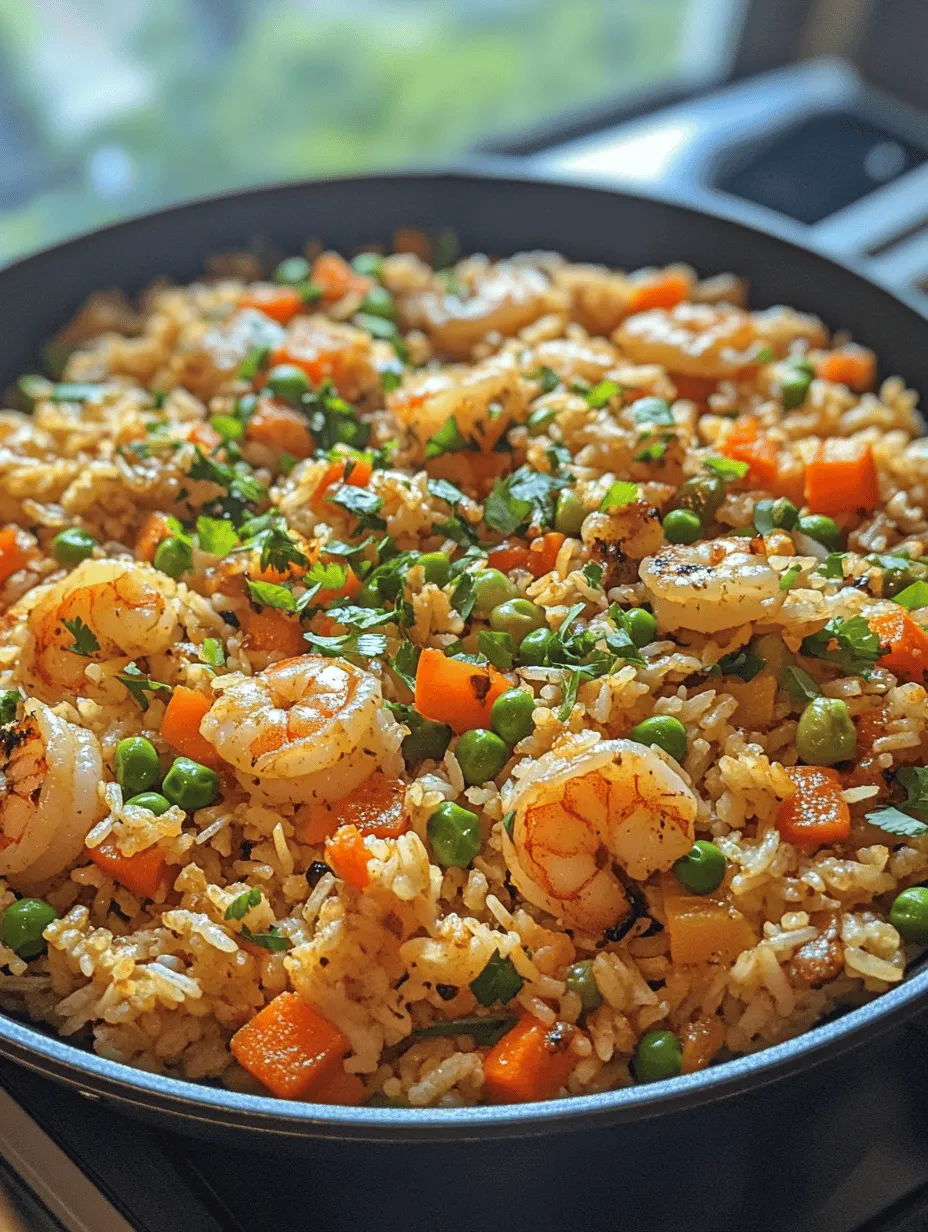Introduction
Welcome to the vibrant and flavorful world of Ajun Shrimp Fried Rice, a dish that encapsulates a perfect balance of taste, texture, and nutrition. This culinary gem has its roots deeply embedded in the Southeast Asian cuisine, celebrated for its versatility and ease of preparation. Ajun Shrimp Fried Rice has become a popular staple in many households, offering a quick meal option that can be customized according to personal preferences and available ingredients. Whether you’re navigating a busy weeknight or hosting a special gathering, this dish promises to satisfy both your palate and your guests.
Fried rice, in general, holds a beloved place in many cultures. It is often seen as a creative way to use leftover rice and vegetables, transforming simple ingredients into a delightful meal. The beautiful medley of shrimp, vegetables, and rice not only brings together a variety of flavors but also provides a hearty and nutritious option for families. The combination of fresh shrimp with colorful vegetables and aromatic seasonings makes Ajun Shrimp Fried Rice not just a meal, but an experience that delights the senses.
Understanding the Ingredients
To master Ajun Shrimp Fried Rice, it is essential to understand the key ingredients that contribute to its unique flavor and texture. Each component plays a vital role in creating a dish that is not only delicious but also visually appealing and nutritious.
Shrimp
Fresh shrimp is the star of this dish, bringing a sweet and briny flavor that elevates the overall taste. Shrimp is not just delicious; it is also packed with nutrients. High in protein and low in calories, shrimp provides essential vitamins and minerals, including selenium and vitamin B12. When selecting shrimp for your fried rice, it’s best to choose fresh or properly thawed shrimp to ensure the best flavor and texture. The brief cooking time needed for shrimp makes it ideal for a quick meal, and its ability to absorb the flavors of surrounding ingredients enhances the dish’s overall appeal.
Jasmine Rice
The type of rice used in Ajun Shrimp Fried Rice is critical to achieving the desired texture. Jasmine rice is a popular choice due to its fragrant aroma and slightly sticky texture when cooked. However, day-old rice is preferred for fried rice dishes, as it tends to be drier, allowing for better frying without becoming mushy. The grains of day-old rice are firmer and have less moisture, which helps in achieving the ideal fried rice texture—fluffy, separated grains that can hold up to the other ingredients without clumping together.
Vegetable Oil
Vegetable oil is essential in the frying process, as it allows for high cooking temperatures while preventing the ingredients from sticking to the pan. When sautéing, using oil with a high smoke point, such as canola or peanut oil, ensures that the shrimp and vegetables cook evenly without burning. The right amount of oil creates a beautiful golden crust on the shrimp and helps to caramelize the vegetables, enhancing their flavors.
Aromatics (Onion and Garlic)
Onion and garlic are fundamental aromatics in many cuisines, and they play a crucial role in flavoring Ajun Shrimp Fried Rice. When sautéed, onions become sweet and tender, while garlic adds a pungent and savory depth to the dish. The process of cooking these aromatics releases their natural oils and compounds, creating an enticing aroma that fills your kitchen. Their transformation during cooking not only enhances the flavor profile but also adds complexity to the dish.
Vegetables
Incorporating colorful vegetables like bell peppers, peas, and carrots not only adds visual appeal but also increases the nutritional value of the dish. These vegetables provide essential vitamins and minerals, as well as a crisp texture that contrasts beautifully with the tender shrimp and rice. The vibrant colors of the vegetables make the dish more inviting, encouraging everyone to dig in. You can customize the vegetable mix based on what’s in season or what you have on hand, making this dish incredibly versatile.
Sauces
The sauces used in Ajun Shrimp Fried Rice are pivotal in achieving depth of flavor and umami. Soy sauce provides a salty, savory base, while oyster sauce adds a hint of sweetness and richness. Sesame oil, with its nutty aroma, rounds out the flavors and gives the dish a signature taste. Together, these sauces create a well-balanced flavor profile that enhances the shrimp, rice, and vegetables. When adding sauces, it’s important to taste as you go to ensure the right balance and avoid overpowering the dish.
Egg
The addition of egg in fried rice is not just for richness; it also contributes to the dish’s texture. Scrambled eggs add a creamy element that binds the ingredients together, creating a cohesive dish. The eggs also provide a source of protein, making the meal more filling. The process of incorporating the egg into the fried rice is simple; it can be cooked separately and then mixed in or added directly to the pan, allowing it to cook alongside the other ingredients.
Seasoning
Finally, the balance of seasoning is crucial for enhancing the flavors of Ajun Shrimp Fried Rice. A pinch of salt and pepper can do wonders, but fresh herbs like cilantro or green onions add brightness and freshness to the dish. These herbs not only elevate the flavor but also add a pop of color, making the dish visually appealing. The finishing touch of herbs provides a fragrant aroma that lingers, inviting everyone to enjoy a bite.
Preparation Steps
Now that we’ve explored the essential ingredients of Ajun Shrimp Fried Rice, let’s delve into the preparation steps. This process is straightforward, making it an accessible dish for cooks of all levels. By breaking down the steps clearly, you can ensure a successful cooking experience.
Preparing the Shrimp
Begin by preparing the shrimp, which involves cleaning and marinating them. Rinse the shrimp under cold water to remove any residual grit or impurities. If you’re using shell-on shrimp, be sure to peel and devein them before cooking. Once cleaned, pat the shrimp dry with a paper towel to remove excess moisture, which can lead to steaming rather than frying.
For maximum flavor, marinate the shrimp in a mixture of soy sauce, a dash of sesame oil, and a sprinkle of cornstarch. The soy sauce infuses the shrimp with a savory depth, while the cornstarch helps create a slight crust when frying, enhancing the overall texture. Allow the shrimp to marinate for about 15-20 minutes while you prepare the other ingredients.
Heating the Pan
The next step is to heat your pan or wok. The right cooking temperature is crucial for achieving the perfect fried rice. Use a large, heavy-bottomed pan or a wok, as it allows for even heat distribution and provides adequate space for tossing the ingredients. Preheat your pan on medium-high heat and add the vegetable oil.
Once the oil is shimmering but not smoking, you know it’s ready for cooking. The right temperature will create a sizzle when the shrimp and vegetables are added, ensuring that they fry rather than steam.
Sautéing Aromatics
After the pan is heated, it’s time to introduce the aromatics. Add the chopped onions to the hot oil and sauté them until they become translucent and fragrant. This process usually takes about 2-3 minutes. As the onions cook, they will soften and begin to release their natural sweetness.
Next, add minced garlic. Be careful not to burn the garlic, as it can turn bitter. Stir continuously for about 30 seconds until the garlic is fragrant. This step is crucial, as the combination of sautéed onions and garlic will form the flavor base for your Ajun Shrimp Fried Rice.
Cooking the Shrimp
Now it’s time to add the marinated shrimp to the pan. Spread them out in a single layer for even cooking. Allow the shrimp to cook undisturbed for about 2-3 minutes, until they turn pink and opaque. Flip them over to cook the other side for an additional 1-2 minutes.
To check for doneness, ensure that the shrimp are no longer translucent in the center. Overcooked shrimp can become tough and rubbery, so it’s essential to watch them closely. Once cooked, remove the shrimp from the pan and set them aside. This allows you to add the rice and vegetables without overcrowding the pan.
With the initial steps completed, you are well on your way to creating a delicious Ajun Shrimp Fried Rice that will impress family and friends. In the following sections, we will continue with the remaining preparation steps, focusing on incorporating the rice and vegetables into this delightful dish. Stay tuned for more tips and insights to perfect your cooking experience!

Adding Vegetables
When crafting a delightful Ajun Shrimp Fried Rice, the order in which you add vegetables plays a crucial role in maintaining their texture and enhancing the overall flavor profile of the dish. Start with firmer vegetables that require a slightly longer cooking time, such as carrots and bell peppers. Sauté these first, allowing them to soften and develop their natural sweetness, which typically takes about two to three minutes.
Next, incorporate vegetables that cook quickly, such as peas and chopped green onions. Adding these later helps to preserve their vibrant color and crunch, providing a satisfying contrast to the softer elements of the dish. Always ensure you stir continuously to evenly distribute the heat, preventing any vegetables from becoming overly mushy. The balance of textures will elevate your fried rice, making each bite an enjoyable experience.
Combining Rice
Properly mixing the rice with the other ingredients is vital to achieving the perfect Ajun Shrimp Fried Rice without mashing the grains. Use day-old jasmine rice whenever possible, as it’s drier and less sticky than freshly cooked rice, allowing for better separation of grains during cooking.
When combining the rice with the vegetables and shrimp, gently fold the rice into the mix rather than stirring aggressively. Use a spatula to lift the rice from the bottom and turn it over, ensuring even distribution without breaking the grains. This technique not only preserves the integrity of the rice but also allows the flavors from the shrimp and vegetables to infuse throughout, creating a harmonious dish.
Flavoring the Dish
Timing is everything when it comes to flavoring your Ajun Shrimp Fried Rice. Once your shrimp are cooked through and the rice is well combined, it’s time to add your sauces—such as soy sauce, oyster sauce, and a splash of sesame oil. Begin with a light drizzle of soy sauce, then gradually add the oyster sauce, which brings depth and umami to the dish.
It’s essential to add these sauces towards the end of the cooking process. This approach ensures that the rice absorbs the flavors without becoming overly salty or soggy. Stir well to coat all ingredients evenly, allowing the sauces to mingle with the heat of the pan for a minute or two. This quick infusion will maximize the flavor without compromising texture.
Scrambling the Egg
To achieve the perfect integration of scrambled eggs into your Ajun Shrimp Fried Rice, it’s best to cook the eggs separately before folding them into the rice. Start by pushing the rice and vegetables to one side of the pan, creating a space for the eggs. Crack the eggs directly into this space and lightly scramble them with a spatula, allowing them to set slightly before mixing.
Once the eggs are partially cooked but still soft, fold them into the rice mixture. This technique ensures that the eggs are evenly distributed throughout the dish without clumping together. The result is a beautifully rich and creamy texture that complements the other components of the fried rice, making every bite delightful.
Finishing Touches
The finishing touches are what truly elevate your Ajun Shrimp Fried Rice. After combining all the ingredients, take a moment to taste and adjust the seasoning. A pinch of salt or a dash of extra soy sauce can enhance the flavors and ensure a balanced dish.
Additionally, consider garnishing with fresh herbs like cilantro or basil, which can add a refreshing contrast to the savory elements. A sprinkle of sesame seeds can also provide visual appeal and a subtle nutty flavor. These final adjustments are crucial in achieving a harmonious flavor profile, making your fried rice not only delicious but also visually enticing.
Nutritional Benefits
Ajun Shrimp Fried Rice is not only a flavor-packed dish but also a nutritious option that can be enjoyed by many. Let’s delve into the nutritional profile and health benefits of the key ingredients:
Shrimp as a Protein Source
Shrimp are a fantastic source of high-quality protein while being low in calories. A typical serving can provide around 20 grams of protein, making it an excellent choice for those looking to build or maintain muscle mass. Additionally, shrimp are rich in essential nutrients, including selenium, vitamin B12, and iodine, which play vital roles in metabolism and overall health.
Vegetable Contributions
The mixed vegetables in Ajun Shrimp Fried Rice offer a wealth of vitamins and minerals. Carrots are rich in beta-carotene, which supports eye health, while bell peppers provide a significant dose of vitamin C. Peas add fiber and protein, contributing to digestive health and satiety. By incorporating a variety of vegetables, you not only enhance the dish’s flavor but also boost its nutritional value.
Carbohydrates in Jasmine Rice
Jasmine rice is a primary ingredient in this dish, providing a source of carbohydrates that serve as the body’s main energy fuel. The grains help replenish glycogen stores after physical activity, making it a satisfying option post-workout. Day-old rice is particularly beneficial as it contains resistant starch, which can aid in digestion and provide longer-lasting energy.
Healthy Fats
The inclusion of sesame oil in Ajun Shrimp Fried Rice adds a layer of flavor while also providing healthy fats. Unlike many other oils, sesame oil contains polyunsaturated and monounsaturated fats, which are beneficial for heart health. These healthy fats can help reduce inflammation and lower cholesterol levels, making them a better alternative in your cooking.
Serving Suggestions
When it comes to serving Ajun Shrimp Fried Rice, consider the following ideas to create a well-rounded meal:
Accompaniments
Pair your fried rice with complementary dishes to enhance the dining experience. Crispy spring rolls or egg rolls can provide a delightful crunch, while a light salad with a sesame dressing can add freshness. Alternatively, a bowl of hot and sour soup can be an excellent starter that pairs well with the richness of the fried rice.
Presentation Tips
Garnishing your Ajun Shrimp Fried Rice can significantly enhance its visual appeal. Serve the fried rice in a large, shallow bowl or platter, and consider topping it with a sprinkle of chopped green onions and sesame seeds. For a burst of color, add a few slices of fresh cucumber or radish around the edges. Using fresh herbs as a garnish can also elevate the presentation, making the dish look as good as it tastes.
Variations
One of the joys of cooking is the ability to customize recipes to suit your preferences. For those looking to change things up, consider adding different proteins such as chicken, beef, or tofu. You can also experiment with various vegetables like bok choy, broccoli, or zucchini, depending on what’s in season or what you have on hand. These variations allow you to tailor the dish to accommodate dietary preferences and make it your own.
Conclusion
Ajun Shrimp Fried Rice stands out as a delightful and nourishing dish that combines fresh ingredients with simple cooking techniques. Its versatility makes it a fantastic option for any meal, adaptable to various tastes and dietary restrictions. This recipe not only showcases the beauty of home cooking but also emphasizes the joy of bringing together colorful vegetables, succulent shrimp, and fragrant jasmine rice.
As you embark on this culinary adventure, embrace the process of creating this dish. With each step, you’ll discover the satisfaction of preparing a meal that is not only delicious but also packed with nutritional benefits. So gather your ingredients, follow the steps, and enjoy the wonderful results of your hard work. Ajun Shrimp Fried Rice is sure to become a cherished addition to your culinary repertoire, celebrating the essence of flavor and nourishment in every bite.


